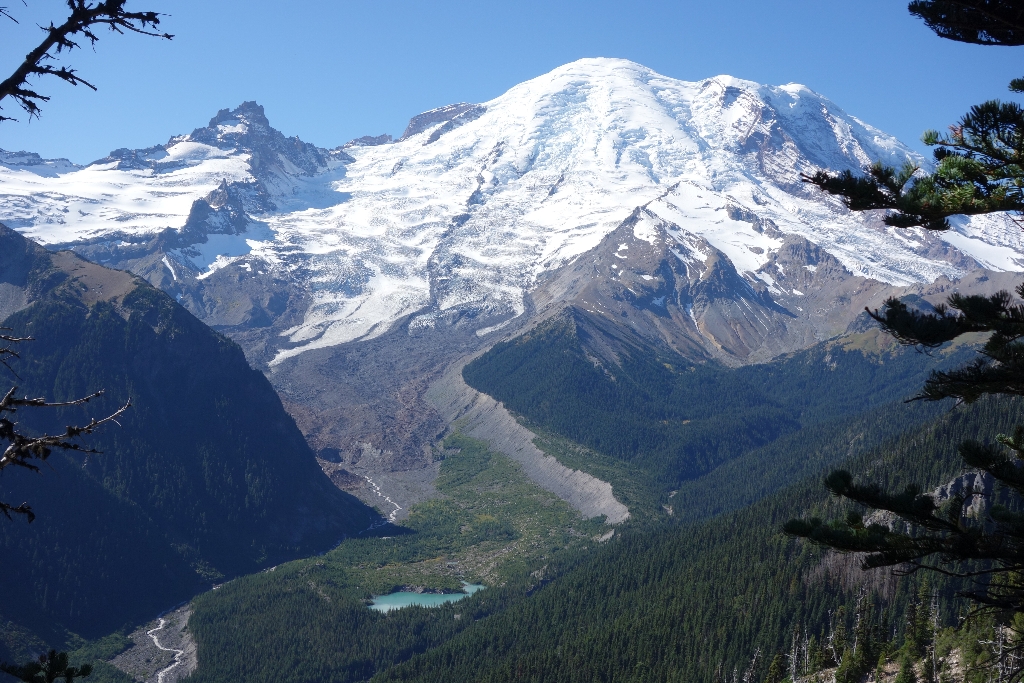
Season: Summer Only (July - September)
Sunrise Road is open to vehicles during the summer only, typically from early July to mid-September.
From the Sunrise parking lot, take the short walk down to the second of the Emmons Vista Overlooks. The trail starts from the left side of the parking lot as you look towards the Sunrise Visitor Center where you may also pick up a trail map.
Sunrise Road Geology – Emmons Vista Overlook 2
In front of you is the Emmons Glacier. It covers 4.3 square miles and is the largest glacier by area not only on Mount Rainier but also in the contiguous United States. The present terminus of the Emmons Glacier is not where the white snow and ice ends, but rather is where the river becomes visible emerging from the dark colored, rock-covered ice front. From here you can see the uppermost Winthrop Glacier, which flows northward from the triangular-shaped Steamboat Prow to form the headwaters of the West Fork of the White River. Carolyn Driedger, U.S. Geologic Survey:
“Much of the appearance of the glacier that we see today has been determined by an event that happened in 1963... Rock fell off Little Tahoma peak on the left side of the glacier, rolled down onto the surface, completely covered the lower glacier, and came part way down the valley... Because of that 1963 rock fall that brought so much rock onto the lower portion of the Emmons glacier, the Emmons glacier has a lot more rock on it, a lot more rock within it, and so the moraines here are a little bit higher than they might have been otherwise.”
Moraines are piles of rock, sand, and silt left behind by glaciers as they carve the landscape. There are several different types of moraines visible from the Emmons overlooks. The terminal moraine forms at the end, or terminus, of the glacier where rocks and other materials picked up by the glacier during times of glacier advance are left behind when the glacier ice melts away, or retreats. Lateral moraines accumulate similarly along the sides of glaciers. A few hundred years ago, the Emmons Glacier extended much farther down the White River Valley than it does today. As it melted and retreated up valley, it left terminal and lateral moraines that you can see below. The small milky-green ponds visible at the bottom of the valley are formed from melt water from ice that broke off from the retreating glacier and was left behind in the core of older terminal moraines. The large, steep lateral moraines skirting the edges of the White River valley were actually left by Little Ice Age glaciers 200–500 years ago. Carolyn Driedger:
“I like to say to people that the Mount Rainier your grandparents see is a little bit different from what you will see and what your grandchildren will see because we have rock fall and changes in the glaciers and sometimes we have volcanic eruptions.”
These modern-day moraines will eventually erode away or perhaps be buried by lavas or other volcanic deposits from Mount Rainier, just like the moraine layers left behind by ancestral glaciers. Future volcanic eruptions and lahars will reshape the mountain and its surrounding valleys. For thousands of years, the mountain has been built up and torn down by volcanic forces, and sculpted and molded by glaciers. These processes leave a mark, and the evidence is visible on a grand scale throughout Mount Rainier National Park.
A wayside exhibit panel provides additional information about Mount Rainier. Continue along the trail for additional views of the White River Valley and the subalpine meadows of Sunrise or return the way you came to get back to the parking lot. Exhibits in the Sunrise Visitor Center further explore the dramatic geology of Mount Rainier and the Sunrise area.
Is there something we missed for this itinerary?
Itineraries across USA


















































